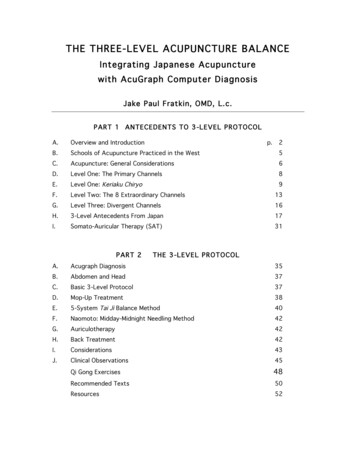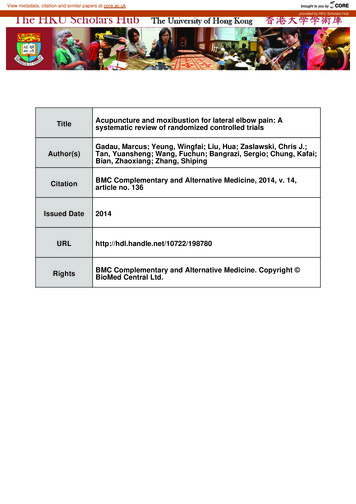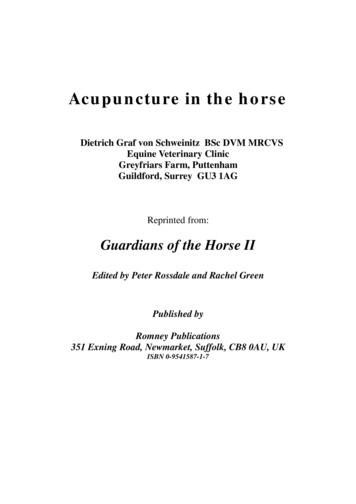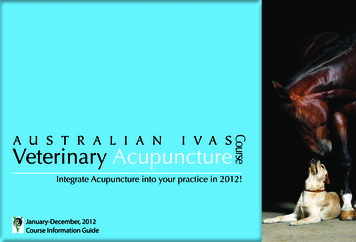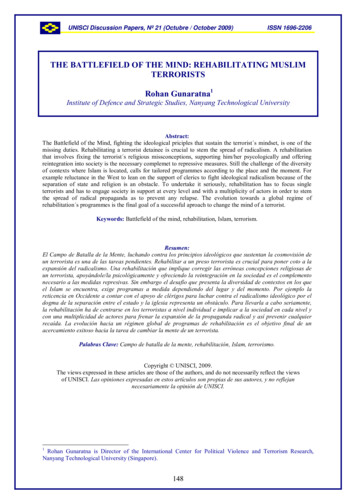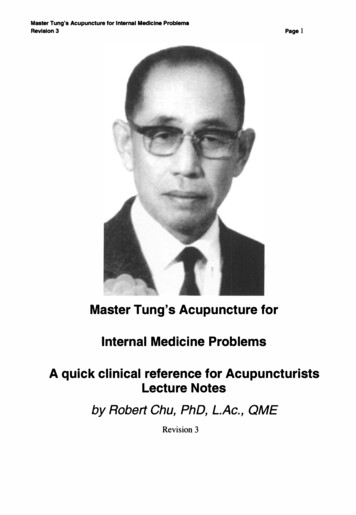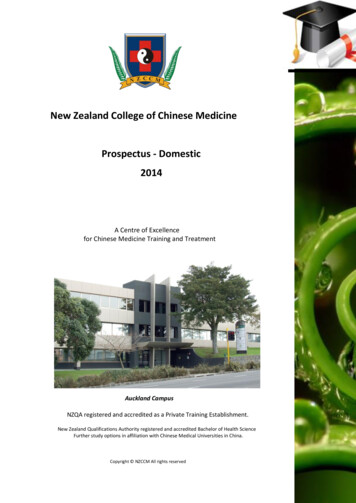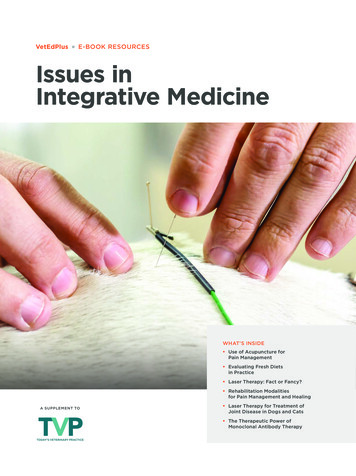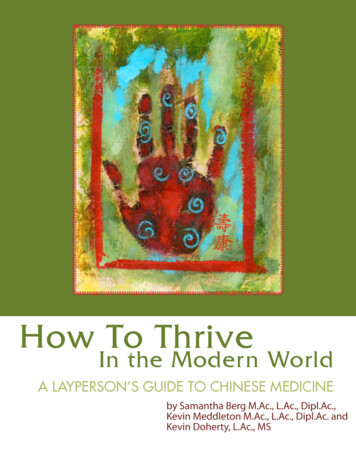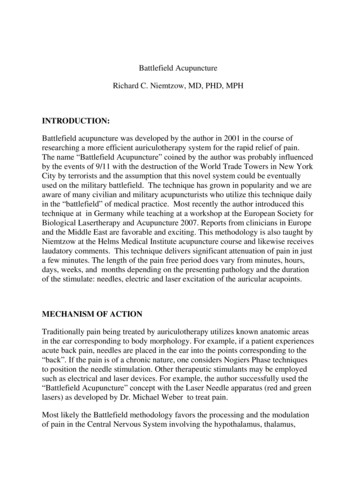
Transcription
Battlefield AcupunctureRichard C. Niemtzow, MD, PHD, MPHINTRODUCTION:Battlefield acupuncture was developed by the author in 2001 in the course ofresearching a more efficient auriculotherapy system for the rapid relief of pain.The name “Battlefield Acupuncture” coined by the author was probably influencedby the events of 9/11 with the destruction of the World Trade Towers in New YorkCity by terrorists and the assumption that this novel system could be eventuallyused on the military battlefield. The technique has grown in popularity and we areaware of many civilian and military acupuncturists who utilize this technique dailyin the “battlefield” of medical practice. Most recently the author introduced thistechnique at in Germany while teaching at a workshop at the European Society forBiological Lasertherapy and Acupuncture 2007. Reports from clinicians in Europeand the Middle East are favorable and exciting. This methodology is also taught byNiemtzow at the Helms Medical Institute acupuncture course and likewise receiveslaudatory comments. This technique delivers significant attenuation of pain in justa few minutes. The length of the pain free period does vary from minutes, hours,days, weeks, and months depending on the presenting pathology and the durationof the stimulate: needles, electric and laser excitation of the auricular acupoints.MECHANISM OF ACTIONTraditionally pain being treated by auriculotherapy utilizes known anatomic areasin the ear corresponding to body morphology. For example, if a patient experiencesacute back pain, needles are placed in the ear into the points corresponding to the“back”. If the pain is of a chronic nature, one considers Nogiers Phase techniquesto position the needle stimulation. Other therapeutic stimulants may be employedsuch as electrical and laser devices. For example, the author successfully used the“Battlefield Acupuncture” concept with the Laser Needle apparatus (red and greenlasers) as developed by Dr. Michael Weber to treat pain.Most likely the Battlefield methodology favors the processing and the modulationof pain in the Central Nervous System involving the hypothalamus, thalamus,
cingulate gyrus and cerebral cortex structures. fMRI research studies from Dr. ZHCho suggests involvement of these structures.TECHNIQUETypically ASP needles which are semi-permanent needles have the characteristicsof remaining in the ear acupoints for up to 3-4 days before being pushed outtoward to the surface by the previous flattened epidermis.The following acupoints are sequentially administrated: Cingulate gyrus, thalamicnuclei (anterior), omega 2, point zero, and Shen Men. The clinician afterperforming a proper history and physical evaluation of the patient complaining ofpain, initiates the “Battlefield Acupuncture“ technique.SEQUENCE OF NEEDLES(both ears) 1. CINGULATE GYRUS2. THALAMUS3. OMEGA 24. POINT ZERO5. SHEN MEN1. Either the left or right ear is chosen for the placement of the needles.2. An ASP needle is inserted into the cingulated gyrus.
Cingulategyrus
1. The patient is allowed to ambulate for about 2 minutes to determine whetherpain attenuation has occurred. If no pain attenuation has occurred, an ASPneedle is inserted into the cingulate gyrus of the opposite ear and the patientambulates to determine the new pain level.2. If pain attenuation has been achieved via the cingulated gyrus, another ASPneedle is placed in the anterior thalamic in the ear that has produced themost pain attenuation. The patient ambulates and the new pain level isdetermined.Thalamus
3. Whichever ear insertion produces pain attenuation, ASP needles are placedin a similar sequential manner into omega 2, Shen Men and point zero.Omega 2
Note the placement of the ASP needle on the Helix RootPoint Zero
Shen Men4. Whichever ear insertion produces pain attenuation, ASP needles are placedin a similar sequential manner into omega 2, Shen Men and point zero.5. After the dominant ear has received ASP needles in all the “BattlefieldAcupuncture” points, the pain level is evaluated. If the pain level is 0-1/10,the therapeutic goal is achieved. In the case where the pain level is above1/10, the contra-lateral ear is needled in a similar manner.6. The maximum number of ASP needles in each ear is 5. If the “posterior”thalamic point is employed the number is raised to 6. The posterior Thalamicis sometimes difficult to pique. Note: that the Thalamus Point is normallylocated in the posterior aspect of the antitragus. Difficulty in placing aneedle in that area can be overcome by placing the needle in the anteriorarea of the antitragus similar pain attenuation.RESULTS:
PATIENTSALL FAILED WESTERN PAIN MEDICATIONS(data developed by Niemtzow)A 40 y/o M Sciatic LBP 10/10 4 weeks TX: 1/10F/U: 3 days: 9/10B 52 y/o M Lt Shoulder Pain Bursitis 7/10 1 month TX: 0/10 F/U: 10 days: 2-3/10C 36 y/o F 6 years Elbow and Leg Pain 7/10 TX: 1/10 F/U: 8 days: 3/10D 43 y/o F 9 years TMJ 4/10TX: 0/10 F/U: 2 days: 5/10E 77 y/o F 10 months Fibromyalgia 6/10 pain TX: 2/10 F/U: 2 days: 3/10F 24 y/o F 5 years Carpal Tunnel bilat 4-5/10 TX: 0/10 F/U: 4 days: 4/10G 21 y/o F 2 years TMJ 4/10 TX: 1/10 F/U: 2 days: 2/10H 78 y/o F 7-8 years Left Hip / DJD pain 8/10 TX: 2/10 F/U: 3 days: 1/10I 50 y/o F 17 years Fibromyalgia Pain 9/10 TX: 0/10 F/U: 5 days: 6.5/10The patient should experience a reduced pain period ranging from minutes, hours,days, weeks or months depending on the pathology treated. The “Battle FieldAcupuncture” may be repeated many times. The clinician should observe the ear
for irritation or infection. The author has not experienced any infections in the ear.In some cases the patient will experience healing and will achieve a long lastingpain free period. Other patients who usually are older and have more complicatedpathology will not experience healing. The needles will serve to take the place ofpain medication. The author has found that treating a patient with ASP needlesbiweekly is sufficient in most cases.DISCUSSION:Military use of this technique centers about the pain free period when a narcoticcannot be used that would produce lethargy and as a result would cancel a criticalmission. Because these points are most likely dealing with pain processing at thecentral nervous system level, a general quick response to all pain patterns occurs;simple and complex etiologies. Because the ears are almost always accessible, thismethod is very convenient and simple to practice without undressing the patient;especially during combat situations.Generally speaking, I find that the specific combination of Omega 2, Shen Menand Zero Point, bilaterally, without walking the patient, but with fast insertion ofthe needles appears extremely beneficial for resolving most migraine headaches.This should be first accomplished, bilaterally, with regular acupuncture needlesand then after the termination of the migraine, the needles are withdrawn and thegold ASP needles are inserted without walking the patient.CONCLUSION:This technique has been successfully taught to many physicians. The majority ofmy colleagues report immediate results. In my quest to even better the performanceof the “Battlefield Acupuncture” two major modifications have been developedand remain very simple to apply. A third modification involves stimulating theASP needles with fluorescent dyes plus ultraviolet light that most likely agitatesthe electrons in the ASP needles to stimulate the acupoint. As with allmodifications it is best to test these concepts with a clinical trial to make sure thatthe concept really works. Future research should determine the mechanism ofaction of this technique. A study involving fMRI and PET scan would beappropriate. In any case this technique is presented to you the clinician to serveyour everyday pain challenges and aspire more development and research.
The name “Battlefield Acupuncture” coined by the au thor was probably influenced by the events of 9/11 with the destruction of the World Trade Towers in New York City by terrorists and the assumption that this novel system could be eventually used on the military battlefield

